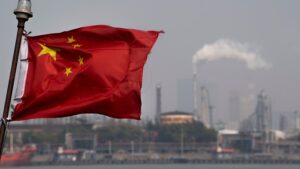
(Energy Chamber, 22.Mar.2023) — The Energy Chamber of Trinidad & Tobago was delighted to collaborate with the European Union and Caribbean Export Development Agency (Caribbean Export) in a webinar on the EU’s Carbon Border Adjustment Mechanism (CBAM) held earlier today. Dr. Thackwray Driver, President and CEO of The Energy Chamber moderated the webinar with stakeholders across the Caribbean, many from the energy sector in T&T.
The webinar involved around 100 participants, mostly from the private sector.
The Carbon Border Adjustment Mechanism (CBAM) is a tool that is developed by the European Union to put to put a fair price on the carbon emitted during the production of carbon intensive goods that are entering the EU, and to encourage cleaner industrial production in non-EU countries. CBAM is essentially a carbon tariff which will be applied to some carbon intensive products entering the European market.
During the webinar, EU officials indicated that there will be a gradual introduction of the CBAM and will be aligned with the phase-out of the allocation of free allowances under the EU Emissions Trading System (ETS) to support the decarbonization of EU industry. During the period 2023-2025 the EU will monitor and report on the implementing rules to be adopted with a view to full implementation of CBAM in 2026.
This mechanism has potential impact for exporters of commodities originating outside of the European Union, including from the Caribbean. The CBAM will initially apply to imports of certain goods and selected precursors whose production is carbon intensive and at most significant risk of carbon leakage: cement, iron and steel, aluminum, fertilizers, electricity, and hydrogen.
The Energy Chamber has identified this as one of the potential opportunities to encourage decarbonization in the energy sector in T&T. This is embodied in one of the areas in the Energy Chamber’s “Six-point plan to secure new natural gas supplies and maximize exports from Trinidad & Tobago: 2022 – 2030”, in the area on “Investing in reducing carbon intensity of operations and products.” This has potential to affect some of T&T’s downstream petrochemical exports in the future. In particular, ammonia, steel and potentially, methanol and LNG.
The Energy Chamber has long advocated for a pricing mechanism for carbon. This mechanism will likely be the first carbon tax on trade in products, but other major markets are looking at similar mechanisms including the United States, It is critical for the industry in T&T to invest in technologies to become more efficient and to seek opportunities to decarbonize and meet the national and global CO2 reduction targets.
In addition, it is critical for government to encourage accelerated development of technologies to support the decarbonization thrust which include creating opportunities for carbon capture storage and utilization and encourage further investment in renewable energy including solar and wind which can support the establishment of green inputs into the petrochemical industry.
____________________

